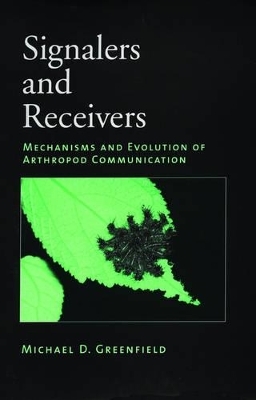
Signalers and Receivers
Mechanisms and Evolution of Arthropod Communication
Seiten
2002
Oxford University Press Inc (Verlag)
978-0-19-513452-0 (ISBN)
Oxford University Press Inc (Verlag)
978-0-19-513452-0 (ISBN)
Because of their minute body size most arthropods have problems sending and receiving acoustic and optical information. This book presents the story of how this group of animals use chemical signalling - pheromones, sound, vibration, and light - for sexual and social communication.
In most terrestrial and aquatic habitats, the vast majority of animals transmitting and receiving communicative signals are arthropods. This book presents the story of how this important group of animals use pheromones, sound, vibration, and light for sexual and social communication. Because of their small to minute body size most arthropods have problems sending and receiving acoustic and optical information, each of which have their own severe constraints. Because of these restraints they have developed chemical signaling which is not similarly limited by scale. Presenting the latest theoretical and experimental findings from studies of signaling, it suggests that close parallels between arthropods and vertebrates reflect a very limited number of solutions to problems in behavior that are available within the confines of physical laws.
In most terrestrial and aquatic habitats, the vast majority of animals transmitting and receiving communicative signals are arthropods. This book presents the story of how this important group of animals use pheromones, sound, vibration, and light for sexual and social communication. Because of their small to minute body size most arthropods have problems sending and receiving acoustic and optical information, each of which have their own severe constraints. Because of these restraints they have developed chemical signaling which is not similarly limited by scale. Presenting the latest theoretical and experimental findings from studies of signaling, it suggests that close parallels between arthropods and vertebrates reflect a very limited number of solutions to problems in behavior that are available within the confines of physical laws.
1. Communication in a Lilliputian World ; 2. Signal Theory and the Language of Communication ; 3. Chemical Signaling and the Olfactory Channel ; 4. Sound and Vibration and the Mechanical Channel ; 5. Bioluminescence and Reflected Light and the Visual Channel ; 6. Sexual Selection and the Evolution of Signals ; 7. Signal Evolution: Modification and Diversification
| Erscheint lt. Verlag | 28.3.2002 |
|---|---|
| Zusatzinfo | numerous halftones and line drawings |
| Verlagsort | New York |
| Sprache | englisch |
| Maße | 157 x 234 mm |
| Gewicht | 730 g |
| Themenwelt | Naturwissenschaften ► Biologie ► Evolution |
| Naturwissenschaften ► Biologie ► Zoologie | |
| ISBN-10 | 0-19-513452-4 / 0195134524 |
| ISBN-13 | 978-0-19-513452-0 / 9780195134520 |
| Zustand | Neuware |
| Haben Sie eine Frage zum Produkt? |
Mehr entdecken
aus dem Bereich
aus dem Bereich
Komplette Neuübersetzung. Mit einem Nachwort von Josef H. Reichholf.
Buch | Hardcover (2018)
Klett-Cotta (Verlag)
CHF 67,20
Wie die Vernichtung der Arten unser Überleben bedroht - Der …
Buch | Softcover (2023)
Penguin (Verlag)
CHF 20,95


